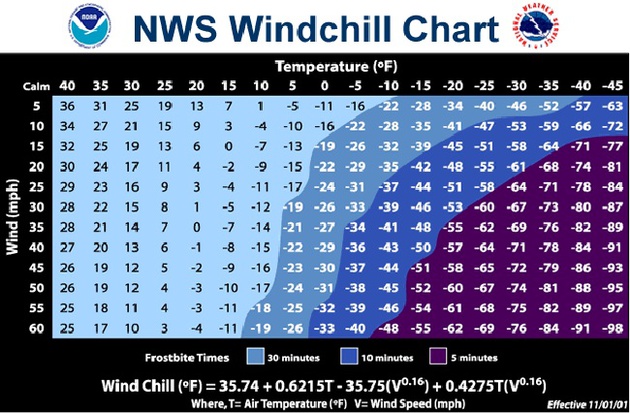
It's one thing to take on a home-improvement project, but patching a hole in a wall is like a walk in the park compared with figuring out the wind chill.
Here’s the formula, courtesy of the National Weather Service:
Wind chill (ºF) = 35.74 + 0.6215T - 35.75(V^0.16) + 0.4275T(V^0.16)
Where: T = Air Temperature (F)
V = Wind Speed (mph)
^ = raised to a power (exponential)
Less important than calculating windchill – here you'll find a handy calculator that does the work for you – is understanding its purpose and the warning signs it represents.
“The windchill temperature is how cold people and animals feel when outside. Windchill is based on the rate of heat loss from exposed skin caused by wind and cold. As the wind increases, it draws heat from the body, driving down skin temperature and eventually the internal body temperature. Therefore, the wind makes it FEEL much colder. If the temperature is 0 degrees Fahrenheit and the wind is blowing at 15 mph, the wind chill is -19 degrees Fahrenheit. At this windchill temperature, exposed skin can freeze in 30 minutes.”
Some other facts about wind chill:
• The Wind Chill Temperature (WCT) index, as it is formally known, calculates wind speed at an average height of 5 feet. That is the typical height of an adult human face.
• Wind chill only applies to people and animals, not inanimate objects.
• The wind chill chart above is meant as a starting point: The National Weather Service encourages us to be more cautious with children, seniors and people whose health is compromised.
• Frostbite only can occur when the actual air temperature near your skin is below freezing. Wind chill can’t bring the temperature for humans and animals to below freezing if the thermometer says the temperature is above freezing. However, you could get hypothermia from exposure to cold.
• Wind chill temperature is only defined for temperatures at or below 50 degrees F and wind speeds above 3 mph. Bright sunshine may increase the wind chill temperature by 10 to 18 degrees F.
When it gets cold enough to invoke wind chill, it’s a good idea to confine your activities indoors.
Maybe you can repair that hole in the wall.

Discussion
There are no comments yet.